Science and poetry dovetail in Anne Simpson’s latest collection, Is, in which she meditates on what it means to be human. She starts with the cell and examines what happens as it divides and multiplies. As she moves from the “world not yet world” through the flood and war, intimate scenes of love, parenthood, illness and death emerge.
Simpson explores the synthesis of form and content while retaining the lyricism that distinguished earlier works like the award-winning Light Falls Through You. In “Book of Beginnings,” the words hum with the energy of creation and the lack of punctuation enhance the melodic fluidity of the lines:
before opening the crisp envelope of morning before afternoon and afternoon’s picked threads before evening before the scattering of evening’s fish scales before crumpled dark before tarnished dark before glovesoft dark
A similar rhythm emerges in “Cell Division.” Her playful arrangement captures the hurriedness and hesitation of seduction: the poem begins as one column and is split into progressively smaller text and additional columns on subsequent pages.
By contrast, “Divide, Break” misses the mark even though it is similarly formatted: the repetition of the word “break” in different contexts is too elementary in concept and execution to warrant a place in Is. But these misses are rare.
Water undulates throughout Is, appearing in numerous poems including “Viva Voce” and “Flood Translated.” It is the vessel that brings life into this world, but also bears it away. In particular, “Boat of Dawn, Boat of Dusk” with its elegiac underpinnings lingers in the reader’s mind:
She journeys. Goes in and out of her body,
water, its lapping clocks. Hears boat thumping against boats. The lighting
of paper lanterns.
Constellations, opening and closing.
The silences, denoted by the spaces in the text, are equally important, symbolic of the uneven tides of her breath.
The collection culminates in “Double Helix” in which Simpson uses the double-stranded coil of DNA to analyse the intertwining threads of two lives, create the poem’s format and signify life’s cyclical disposition. Indeed, the poem starts and finishes “with the ending poised inside the beginning.”
In the process Simpson produces her version of the genetic code: “This is what we’re made of:/unlit dust of stars./Blood,/bone./Salt/on skin.” But beyond these “physical” attributes are the things that make us human: our joys and failures, proclivities and travesties — and the events that surround them.
Simpson acknowledges Canadian pianist Glenn Gould’s recording of Bach: The Goldberg Variations for the poem’s shape and concept: counterpoint describes the relationship between two or more voices that are distinct in rhythm and contour, but must remain polyphonic. Gould described it in the liner notes “as music which observes neither end nor beginning.” It gets to the heart of what Is is about: the circular nature of life and how the sum of its parts can render the whole more sublime.—Cara Waterfall
Cara Waterfall is a Toronto-based writer and regular rabble contributor.



